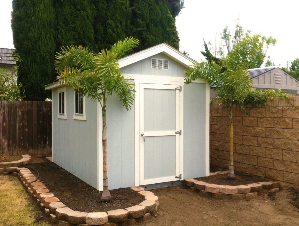
Architectural control sets the “bar,” if you will, or expectation of design and structural aesthetics within a community. Maintaining architectural control within a planned community is critical for everyone – Think about it: you have owners trying to sell their properties at the highest values, you have buyers that want to purchase a well-maintained home surrounded by equally well-maintained homes and common areas. You also have professionals for hire and volunteers (Community Managers, Legal Counsel, Business Partners, Board and Committee Members, etc.) that are needed to aid in the operation of a community. If you are someone from the aforementioned groups, would you want to sell, purchase, or work with a community that has lost sight of maintaining architectural control and compliance? Probably not.
So how does a community keep from losing sight of their architectural design standards? The onus is going to fall on collaboration between the various stakeholders identified above – because each stakeholder serves a special purpose in the process, it should be obvious that working together will be key to success. Architectural compliance requires an understanding of applicable legal requirements and limitations, community-specific standards and practices, and construction industry recommendations and standards. What follows are perspectives and advise from members of these stakeholders – specially lawyers, community managers, and business partners – for how communities can promote and attain architectural compliance.
“Is that legal? Well, it depends…”
The recent trend of Virginia court jurisprudence is clear - private property rights are to be protected and covenants restricting the free use of property are to be strictly construed. What does this mean for architectural control in community associations? Well, in short, regulation of individual lots does not come in the form of a blank check - governing boards must be diligent in ensuring architectural control authority is exercised only in accordance with the express terms found in recorded covenants.
This principle was pervasive in a 2019 opinion of the Virginia Supreme Court in the case of Sainani v. Belmont Glen Homeowners Association. While Sainani could be an article on its own, the most instructive aspect of the case from an architectural control aspect is the lengths the Court went to invalidate a rule regulating the display of holiday lights. The association identified no less than four provisions in its declaration as the basis of authority for its holiday lighting rules, including a covenant that authorized the association to “regulate the external design and appearance of the Property.” One-by-one, the Court shot down each provision relied upon the association for the rule it, relying on various principles of interpretation that evinced the Court’s clear aversion to covenants.
 Ultimately, the Court determined that the recorded covenants did not provide the association with the authority to regulate temporary holiday displays. In concluding its opinion, the Court wrote that “design-control powers ‘are not necessary to the effective functioning of the community,’ and ‘powers to control the design of individual properties within the community do not necessarily further public interests or fulfill reasonable expectations of the property owners.’” Despite not being a part of the legal basis for the Court’s decision (in my humble opinion), this statement from the Court is striking, particularly as architectural control is often one of the first things you think of when describing community association responsibilities.
Ultimately, the Court determined that the recorded covenants did not provide the association with the authority to regulate temporary holiday displays. In concluding its opinion, the Court wrote that “design-control powers ‘are not necessary to the effective functioning of the community,’ and ‘powers to control the design of individual properties within the community do not necessarily further public interests or fulfill reasonable expectations of the property owners.’” Despite not being a part of the legal basis for the Court’s decision (in my humble opinion), this statement from the Court is striking, particularly as architectural control is often one of the first things you think of when describing community association responsibilities.
In a post-Sainani world, given the Court’s clear trend to read and interpret covenants strictly and in favor of the free use of property, it is important for boards of directors to review their recorded documents carefully (typically declarations for property owners’ associations or declarations and bylaws for condominium unit owners associations). Just because a rule is included in a community’s published architectural design guidelines does not mean that the rule is legally enforceable. Knowing the bounds of association authority to regulate architectural standards is crucial for ensuring that guidelines created or adopted by the board do not exceed association authority.
“Enough Legal Mumbo Jumbo, What Do We Do?”
Start with your architectural control standards or design guidelines – these are typically policy documents adopted by the Board of Directors to put some “meat on the bones” of the covenants. The whole point is to establish architectural standards to set clear expectations for residents. If your community does not have standards yet, create some!
When it comes to creating (or updating) your standards and design control procedures (e.g., process to review and decide on architectural modifications within the community), consider enlisting community volunteers and trusted Business Partners to help develop standards that will create and preserve architectural harmony. Business Partners can be particularly helpful to community leaders by helping plan, as an impartial third-party, the future maintenance needs of the association based on construction trends and conformity to the association’s overall aesthetics. Additionally, Contractors may have a sense as to whether any particular construction materials or practices should be incorporated or considered in the guidelines.
 Of course, be sure not to forget that “legal mumbo jumbo” we referenced above because your guidelines must be consistent with your recorded covenants. For example, your community’s declaration expressly states that “No . . . shed . . . shall be erected, used or maintained on any Lot except in connection with construction or marketing activities by the Declarant.” However, if your design guidelines expressly allow sheds, you may have a problem…This discrepancy between the declaration and the guidelines can create a serious issue for enforcement if a homeowner installs a shed the Board approves in accordance with the guidelines. In that case, the association may not be able to require the homeowner to remove the shed because the shed was approved and the guidelines specifically allow the shed; meanwhile, a homeowner may have a legitimate claim against the Association for permitting a shed that the declaration prohibits. For this (and other) reasons, it is a good idea to compare your community’s design guidelines against the recorded covenants to ensure that the guidelines do not conflict with or attempt to regulate a structure or behavior that is not addressed in the covenants. *Hint: your Association’s attorney is well-versed in this review and can give you good advice*
Of course, be sure not to forget that “legal mumbo jumbo” we referenced above because your guidelines must be consistent with your recorded covenants. For example, your community’s declaration expressly states that “No . . . shed . . . shall be erected, used or maintained on any Lot except in connection with construction or marketing activities by the Declarant.” However, if your design guidelines expressly allow sheds, you may have a problem…This discrepancy between the declaration and the guidelines can create a serious issue for enforcement if a homeowner installs a shed the Board approves in accordance with the guidelines. In that case, the association may not be able to require the homeowner to remove the shed because the shed was approved and the guidelines specifically allow the shed; meanwhile, a homeowner may have a legitimate claim against the Association for permitting a shed that the declaration prohibits. For this (and other) reasons, it is a good idea to compare your community’s design guidelines against the recorded covenants to ensure that the guidelines do not conflict with or attempt to regulate a structure or behavior that is not addressed in the covenants. *Hint: your Association’s attorney is well-versed in this review and can give you good advice*
Once you have a good draft prepared, share the information with the community and consider seeking additional input from your neighbors. Then, when your design guidelines are finally adopted, make sure they are easily accessible to existing and new homeowners and residents, and take care to effectively communicate the guidelines to the community. For example, along with a copy of the guidelines, the Association could provide educational material identifying parts of home exteriors so homeowners can more clearly understand the terms of the guidelines. Community newsletters can also be used effectively to inform homeowners of changes to the guidelines and maintenance tips for different seasons.
But it doesn’t stop here! The guidelines should be reviewed periodically to allow for changes that permit modernization and reduced maintenance materials (e.g., composite vs. vinyl) as they continue to become available and popularly used. And of course, the laws impacting community associations will assuredly change.
“Ok, We Have Guidelines. Now What?”
A critical component to your community’s guidelines and ensuring the community evolves in a way that is architectural and aesthetically consistent is through the architectural review process – the process through which owners seek approval for changing exterior improvements to their home. Your guidelines should incorporate the process for how architectural modification applications are reviewed and approved or denied. It is important to have clear application procedures to set the expectations of the Applicant, the Management Team, and the Committee or Board deciding on the application. Some examples of items to be considered when creating your application procedures include:
- Detail the necessary supporting documents required to be provided with the application.
- Be specific on if and which neighbors’ signatures are required and for what modifications.
- Detail the timeline for review and decision (and make sure the timeframes established in your covenants are accurately incorporated).
- Detail how applicants are notified of decisions.
- If there is a process to appeal application decisions, make sure the appeal process is clear and serves the intended purpose.
While a great deal of importance should be put on your community’s design guidelines and architectural review process, having volunteers to serve on the Committee and support the Board is equally important. Never lose sight of actively recruiting community volunteers and take care to train them so they feel comfortable enforcing the guidelines, reviewing and deciding on applications, and identifying when to seek further guidance from the Board, management, legal counsel.
As applications and decisions flow in the community, be sure to formally document the decisions made by the Board or Architectural Review Committee. Maintain that documentation in the Association’s books and records and encourage the homeowner to keep a copy as well. As the community ages, operations may change. You may get new Board and Committee Members, change in homeowners, and even a change in the Managing Agent, but if the architectural decisions are well documented, you will always have the history.
“But What About Those Residents That Violate Our Guidelines & Covenants?”
A key to getting compliance from owners is consistent and uniform enforcement. But before we get to enforcement, strong consideration should be given to establishing a process to identify violations. To that end, continuous community inspections to identify violations are necessary to preserve a well-maintained community and ensuring compliance with the design guidelines.
 Associations (through a Committee or Managing Agent) should perform routine inspections to identify violations such as lawn maintenance and trash/storage of exterior items. The routine inspections should be supplemented by periodic comprehensive inspections and, of course, inspections done in anticipate of resale, both of which are more in depth and look for exterior maintenance items and architectural modifications. Here are some suggested tips for inspections:
Associations (through a Committee or Managing Agent) should perform routine inspections to identify violations such as lawn maintenance and trash/storage of exterior items. The routine inspections should be supplemented by periodic comprehensive inspections and, of course, inspections done in anticipate of resale, both of which are more in depth and look for exterior maintenance items and architectural modifications. Here are some suggested tips for inspections:
- Develop an inspection checklist and share the checklist with the community before the inspection occurs.
- Communicate the purpose of the inspections – generally, to keep the community in a neat and orderly condition to promote the community welfare and preserve property values.
- Be familiar with exterior home components and clearly communicate what the owner needs to address when citing a violation.
- Take time- and date-stamped photos of any identified violation.
When conducting inspections, it is important to remember the purpose of the inspection and to identify violations consistently and uniformly – all homes must be treated the same. Understand that when serving as an inspector, you have a limited scope on identifying violations. It is obvious when there is a newly constructed deck, discoloration on the siding, or even wood rot on the window trim. However, you are not expected to identify structural integrity or deficiencies. This is where, as a volunteer or Managing Agent, you fall back on your training and enlist the help of your trusted Business Partners – assuming the Association has a role to play when it comes to maintenance.
Once violations are identified, the next step is to begin the process of notifying homeowners of the noncompliant condition to provide them with an opportunity to cure or correct the violation. This is a process that should be generally established in a Due Process Policy adopted by the Board – a clear and concise Due Process Policy is critical to enforcing the covenants and guidelines effectively. The Policy should be consistent with the requirements set forth in the community association statutes and the governing documents – both with regard to the steps that must be satisfied as well as the sanctions that may be imposed.
Although management works closely with the board to send notices of violation or impose sanctions like violation charges or suspension of privileges, there are some situations where legal intervention may become necessary. First and foremost, consulting with legal counsel early in the violation process - not waiting after sanctions have been imposed when the board is itching to file a lawsuit - provides an opportunity to identify and correct issues or mistakes in the compliance process that may trip the association up later in an enforcement action. Legal counsel can also explain the different sanctions and actions that may be available to the association, including less often used options like self-help (the ability to enter onto a homeowner’s property to cure the violation at the homeowner’s expense) and list the associated pros and cons. Once all statutory due process requirements are met and a plan for encouraging compliance is identified, escalating a violation so that the noncompliant homeowner is aware legal counsel is involved - such as through a well-crafted cease-and-desist letter on law firm letterhead - may be enough to create a constructive reaction from the homeowner.
In the end though, the goal should always be to achieve compliance, not punish our neighbors. Encourage compliance by making it easier for homeowners to understand the standards by which they are being measured. And, when those standards are not met, make the deficiency clear to owners (e.g., with pictures) so there are no questions as to what needs to be done for compliance to be achieved.
Some Parting Thoughts
Achieving architectural compliance requires commitment from not only the Board of Directors, but also its volunteers and of course the residents. However, the Board should not feel alone in having the lead the effort – the professional team supporting the Board, including management, legal counsel, and other business partners, can and should be relied upon to help guide the Board and greater community towards architectural compliance.
We hope these best practices help bring a sense of pride and service to the communities you serve. As a community leader, you have a full support system of subject matter experts to support you every step of the way.
Tiago Bezerra, Esq., Chadwick, Washington, Moriarty, Elmore & Bunn, P.C.
Crystal Coats, FirstService Residential
Lauren Ritter, Esq., Chadwick, Washington, Moriarty, Elmore & Bunn, P.C.
Rebecca Winchester, FirstService Residential
